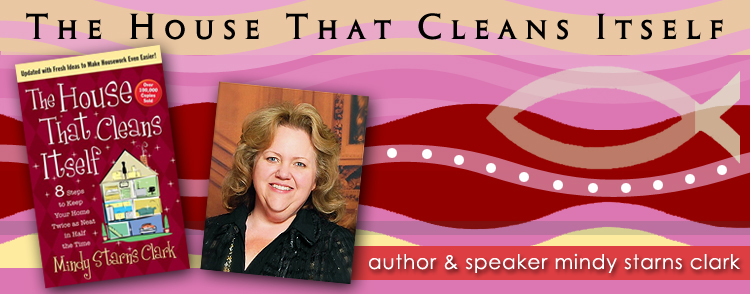Here's more from my recent interview with blogger Kristina Seleshanko, who has been implementing the HTCI system in her home and blogging about it online at Proverbs 31 Woman.
Kristina:
A lot of magazines and books discussing home organization provide costly examples of how to change our homes. Does it have to be expensive to set up an organized home? What are some examples of inexpensive ways to organize problem areas?Mindy: Over the years, I’ve spent a personal fortune on organizational items that proved useless in the end. Somehow, I think I feel better about a problem if I throw money at it!
It is true that sometimes, yes, money needs to be spent, even in a House That Cleans Itself. The broken window blinds that hang crooked and give a messy feel to the whole room need to go. The moldy grout that has resisted every product you’ve thrown at it needs to be replaced.
But more often than not, achieving a House That Cleans Itself costs nothing at all. For example, consider the Sight Zone principle. In the book, I explain that every room in your home has at least one “Sight Zone”—that area you see first when you stand in the doorway and look inside. (A room with multiple doorways will have multiple Sight Zones.) I suggest that you evaluate the Sight Zone for every room in your house. Next, for each of those rooms, decide which elements tend to stay neater and cleaner and which tend to get messier. (For example, you might be pretty good about making the bed but pretty bad about letting your dresser top get cluttered.)
Then—here’s the key—rearrange the furniture in each room so that the part that tends to stay neater is the part that sits in the Sight Zone, while the part that tends to get messy sits in that area of the room you may not see at first.
Using the above example, you would arrange your bedroom so that the bed sits across from the doorway in plain sight, but the dresser rests against the wall beside the door, maybe even with a plant or a curtain on the near side that blocks it from full view of the door. How on earth does this give you a cleaner house? It’s a mental thing, which has physical repercussions. Allow me to explain.
Before implementing this principal, every time you walked into that room, your eyes landed on the messy dresser and your first thought was “This room is a mess.” Even if you came further into the room and saw that the bed was made, your brain said, “Look at that, I tried to do something neat to this messy room.”
Now consider the impact after implementing the Sight Zone principle. If every time you walk into that room you spot the neatly-made bed, your first thought is, “This room is neat and clean.” Then when your eyes finally catch sight of the messier part you think, “Oh look, there’s a messy spot in this clean room.”
Do you see the difference? In the first example, not only does the house feel messier, but if this happens in room after room, the mess can seem so overwhelming and hopeless that you don’t even try to clean. In the second example, not only does the house feel cleaner, but by allowing you to see the mess as an isolated issue you are more likely to jump in and clean it up as well.
Household experts and those who are naturally gifted at housekeeping would probably call this concept crazy. They would instead lecture you about that messy dresser, sell you a bunch of containers, and tell you to try harder.
Not me! I already know the cold, hard truth: If you are housekeeping impaired, lectures won’t change your behavior, containers create a whole new kind of clutter, and no matter how hard you try, you’re never going to change simply through sheer force of will.
That’s what makes the House That Cleans Itself system so different. That’s why it works, even when nothing else has ever worked before.


No comments:
Post a Comment